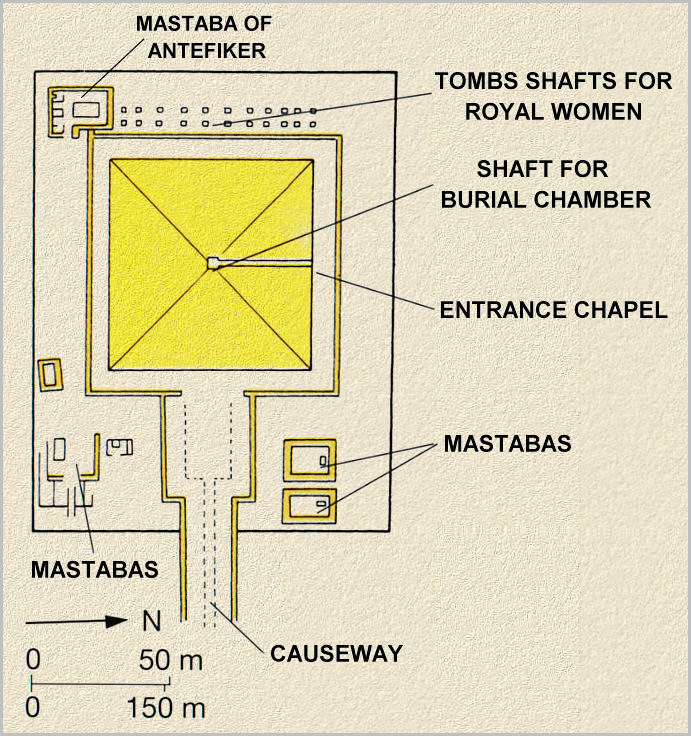
The Pyramid of Amenmehet I
Desert view
The Pyramid of Amenemhet
I
West face of pyramid
North Chapel entrance
Pyramid temple and courtyard
The mastaba of Antefiker
Height 55m
Base 84m
Volume 129,360 cu. m
Slope 54° 27' 44"
Dynasty 12
Satellite Pyramids (0)
Queens Pyramids (0)
Ruled 30 years

Amenemhet I, founding king of the 12th dynasty built his pyramid near the village of el-Lisht. It is believed that his capital, Itj-tawi, is also near this pyramid, it has yet to be discovered. The pyramid was first entered in 1882 by Maspero. In 1894 and 1895, his work was continued by the French archaeological expedition under the direction of Gautier and Jéquier. From 1902 to 1934, a team from the Metropolitan Museum in New York, led by Albert Lythgoe (1868-1934) and Arthur Mace (1874-1928). pursued the investigations further. The pyramid is in a poor state of preservation, only about 20 meters, but several elements of the complex can be made out. The core of the pyramid is of mudbrick with a an outer layer of lime stone. The core has a framework of limestone blocks laid over the diagonals as well ass perpendicular the the pyramid walls. The framework was filled with mudbricks and, if necessary, pieces of less valuable stone and other waste construction materials. High quality limestone blocks were laid over the core constructed in this manner, in a few areas the original limestone casing can still be seen. The entrance into the underground part of the the pyramid was located, as was the general rule in earlier pyramids, in the middle of the north face, at ground level. . Over the entrance stood the north chapel, and in it opened a granite false door, corridor and gradually descended into the burial chamber, the burial chamber is currently below the water table. The mortuary temple on the east side of the pyramid had its own, different name: "High [rises up] Amenemhet's beauty". Of the temple, which was oriented east-west, almost nothing remains, so that reconstructing its original plan is difficult. A few inscriptions and relief fragments found in the temple suggest that it was probably rebuilt during the rule of Senwosret I. Only the upper end of the courtyard end of the courtyard (which was originally open and decorated with relief) has been investigated. The valley temple has not been thoroughly examined, either; on its site is a local Muslim cemetery is now spreading. The Pyramid and mortuary temple were surrounded by two perimeter walls. In the are between them, tombs of the members of the royal family and courtiers were discovered. Alongside the pyramids west wall was a double row of tomb shafts. The Tomb of the vizier Antefiker, an important official during the reign of Amememhet I, was also near the southwest corner of the pyramid. Maspero found blocks from other royal complexes had been used in its construction. In various parts of the complex stones were found that bore the names of the rulers rulers Khufu, Khafre, Unas, and Pepi (II), suggesting that the valley temples of those rulers in Giza in Saqqara already lay in ruin in Amenemhet's time. This view is shared by many Egyptologist including Goedicke who thoroughly examined the blocks and catalogued them. However, Arnold does not exclude the possibility came also from other edifices-for example, from the temples those rulers erected in Middle Egypt, near Lisht.